Poaching of giant clam shells is causing massive scarring of coral reefs
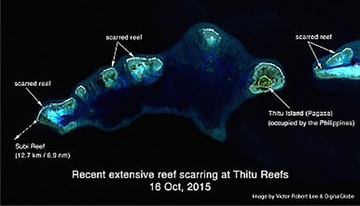
Image by Victor Robert Lee and DigitalGlobe
Satellite images of the South China Sea show man-made scarring of coral reefs on a scale heretofore unappreciated, much of which occurred between 2012 and late 2015.
The scarring, resulting from widespread chopping of reefs by fishermen using propellers mounted on small boats in order to poach giant clam shells, is visible on recent images of at least 28 reefs in the Spratlys and Paracel island groups, in territories disputed by Vietnam, the Philippines, China, Malaysia, Taiwan and Brunei.
Evidence from news reports, aerial photos, videos and commercial websites directly link much, and probably most, of the “prop chop” reef destruction to fishermen from China, particularly from the port of Tanmen on Hainan Island.
Image by Victor Robert Lee and DigitalGlobe
During a period in which Beijing has rapidly built military-capable bases on manufactured islands in the Spratlys, coinciding with the tenure of China’s President Xi Jinping, Tanmen fishermen have harvested prized giant clam shells on a booming industrial scale, traveling more than a thousand kilometers from their home port to shoals and reefs on the opposite side of the South China Sea to find them.
The shell of the giant clam – which can grow to more than a meter in length, weighs over 200 kilograms, and lives more than a hundred years – has become a “white gold of the sea” as its price has risen so dramatically in the past four years that many Chinese fishermen have abandoned pursuing standard food catches.
Giant clam shells have acquired a cachet in China as a luxury item, store of wealth, high-return investment, Buddhist treasure and cultural symbol; jewelry made from it is even touted as conferring supernatural powers and health improvement. It’s as if ivory, jade, pearls, and shark fins, with their spurious claims of physiologic benefits, were all rolled into one.
And giant clam shell products are very hard to counterfeit. The genuine material has fine, irregular growth layers with subtle variations in color that are easily seen under a simple microscope. A high-end pair of the shells could sell for as much as a million yuan ($150,000).
Although giant clams are an endangered species and trading in their shells is prohibited under international laws and nominally under Chinese law, the fishermen’s scraping of the coral reefs has in many cases occurred in the presence of Chinese Coast Guard vessels and on reefs occupied by the People’s Liberation Army Navy.
Numerous Internet commentators in China have supported the activity, claiming, for example, that “Tanmen fishermen harvesting giant clams in the South China Sea are ensuring China’s sovereignty.” This may be true in a literal sense, as controversial land-filling operations by China at Fiery Cross, Subi and Mischief reefs in 2014 and 2015 were immediately preceded by waves of chopper boats cutting their arc patterns across wide areas of the reefs, as if Chinese fishermen had been given the signal to take their bounty of giant clams before the reefs would be permanently buried under millions of tons of sand. Thus reef-chopping activities are of concern beyond the obvious environmental destruction, because they might indicate which spots are next in line for China’s island manufacturing.
Image by Victor Robert Lee and DigitalGlobe
The arc-shaped patterns visible in satellite images of the coral reefs are created by the propellers of small utility boats as they are pulled or pushed laterally in shallow waters. The propellers, on extended shafts, blast away sand and coral that conceal giant clam shells, most of them dead due to prior meat harvesting or the natural life cycle.
Fishermen wearing diving masks scan the bottom for uncovered shells, lift them from the reef bed, and eventually hoist them into the utility boats, which are five to six meters long.
The boats are anchored astern with a long rope or chain against which the propeller action maintains tension during the lateral movement, creating an arc-shaped scar on the reef. Periodically the anchor line may be lengthened and a new path chopped through the reef, resulting in a pattern of concentric partial circles. Thousands of these arc-shaped paths, each of which represents torn-up reef, can be seen in the images presented in this article.
Image by Victor Robert Lee and DigitalGlobe
The poachers’ utility boats in turn deliver the giant clam shells to mother ships anchored nearby, whose cranes lift the harvest into the holds and ultimately lift the utility boats onboard as well, for the return to Tanmen. This simple process, repeated over and over again by hundreds, or thousands, of fishermen employing rudimentary equipment, is the likely cause of almost all the scarring seen in the satellite images.
Image by Victor Robert Lee and DigitalGlobe
Certain dredgers, too, can cause arc-shaped patterns on the seabed, as they use a hub-like system to rotate while they suck sand from below; some of these patterns are observable in satellite images. But most of the dredging of the sort that has uplifted sea bottoms for China’s island building at Subi, Mischief, Fiery Cross, and other reefs, has left few patterns visible in satellite images due to the greater depth of operation.
The BBC’s Rupert Wingfield-Hayes reported in December 2015 that he had observed Tanmen-based fishermen poaching giant clam shells on a reef less than a mile away from the Philippines’ Pagasa (Thitu) Island.
“I could just make out a steel propeller spinning in the distance on the end of long shaft, but it was impossible to tell exactly how the destruction was being carried out,” he wrote. The reef he refers to is a member of the Thitu reef group just east of Pagasa, the site of intense poaching by Chinese fishermen partaking in the white gold rush. (The Thitu Reefs include Sandy Cay, an above-water feature that figures prominently in assessments of the USS Lassen’s Freedom of Navigation operation in October 2015.)
Image by Victor Robert Lee and DigitalGlobe
A time sequence of satellite images of a portion of the Thitu Reefs shows prop chopping in 2013 and 2014, culminating in extensive scarring by late 2015. A satellite image of another portion of the Thitu Reefs, at their eastern extremity, shows an area of scarred reef of approximately 1.36 square kilometers (336 acres).
This magnitude of reef destruction, multiplied across the more than two dozen reefs that have been prop chopped, implies a total that will far exceed the combined reef area China has buried at Fiery Cross, Subi, and Mischief reefs.
Image by Victor Robert Lee and DigitalGlobe
A video posted on YouTube a year before Wingfield-Hayes’ BBC report, attributed to Phillip Imperial and purporting to show Chinese fishermen poaching giant clam shells in the Scarborough Shoal, provides additional details, including underwater footage of a propeller blade on the reef bed and a view of a motor that may be tiltable so as to change the effective depth of the propeller.
The Scarborough Shoal, which was wrested from the Philippines by China in April of 2012 under threat of force, is seen in satellite images to have undergone intense propeller chopping since China’s takeover.
Image by Victor Robert Lee and DigitalGlobe
The Chinese web commerce site Alibaba has two dozen pages dedicated to Tanmen-made products fashioned out of giant clam shells, from bracelets and necklaces to pairs of whole shells and large intricate carvings, some of which are priced at as much as 38,000 yuan ($5,800).
Alibaba’s listings include dedicated entries for giant clam shell products harvested specifically from the Scarborough Shoal (known in Chinese as Huángyán). One company’s listing displays a photo of four Tanmen fishermen on a dock next to a pile of giant clam shells; the four are labeled as having safely returned home after being chased by Philippine authorities while harvesting in the Scarborough Shoal, prior to China taking control of the area.
Image by Victor Robert Lee and DigitalGlobe
When questioned for this article in December 2015, the owner of a 100-person giant clam craft factory in Tanmen said prices for well-formed shells could go much higher than those found on Alibaba. While a low-end pair of uncarved shells could sell for 30,000 yuan ($4,500), a large and especially beautiful pair might go for as much as thirty times that, he said.
Approximately three years ago the Chinese government encouraged the development of Tanmen’s giant clam shell industry, despite its illegality, as a way of augmenting the economy of Beijing’s newly created “Sansha Prefecture” – an embodiment of the country’s self-proclaimed South China Sea territory. More recently, however, the government has given mixed signals regarding the permissibility of giant clam harvesting. But Tanmen companies already have significant raw material inventories to work through.
The owner of the Tanmen factory says prices began to skyrocket in 2012, peaked in 2013 and the first half of 2014, and have since fallen tenfold or more.
“I’m talking about the government crackdown on corruption,” he said. “Before, people would buy several giant clam shell products at one time as gifts to send to officials, but now, even if you buy that, no one would dare to accept it.”
Image by Victor Robert Lee and DigitalGlobe
As a potential site for a new Chinese military installation, the location of Scarborough Shoal, well north of the Spratlys, would be particularly advantageous for exerting control over shipping lanes, interfering with US and Philippine military activities at Subic Base (260 kilometers away), and facilitating transit of Chinese submarines to the Pacific Ocean via the Luzon Strait – one of the few such passages available to China’s navy.
The Scarborough Shoal also dwarfs Fiery Cross, Subi and Mischief reefs; it has at least five straight stretches of contiguous reef crest that could easily accommodate 3,000-meter-long airstrips. Philippine Supreme Court Justice Antonio Carpio, a proponent of his country’s territorial claims under the Law of the Sea, has recently warned that China will soon militarize Scarborough (known in the Philippines as Panatag or Bajo de Masinloc). (READ: Justice Carpio: 'Catastrophe to withdraw China case')
There is abundant evidence that China’s navy and coast guard have been aware of the Tanmen fishermen’s practice of chopping reefs, and tolerated or condoned it. Extensive reef scarring from prop chopping is visible in satellite images of Gaven, Hughes, Cuarteron and Johnson South reefs, all of which have longstanding Chinese military installations.
Those installations have been radically expanded with dredged land fill in the past two years, but the dredging, by large vessels in deeper waters, was separate from the fishermen’s chopping in the shallows across the entirety of these reefs, which spread far beyond the areas of land fill.
Image by Victor Robert Lee and DigitalGlobe
Meanwhile, at Scarborough Shoal, since 2012, Chinese Coast Guard vessels have controlled all access and have effectively provided protection to Tanmen fishermen as they chopped the reefs there for giant clams.
In March 2014 journalists from the Philippine Daily Inquirer flew over Scarborough and reported that giant clam harvesting was underway, while three Chinese Coast Guard vessels were stationed nearby. The Philippine Department of Foreign Affairs filed protests over similar events in 2015.
Illegal fishing is of course carried out by fishermen of other countries in the region besides China. Many Vietnamese and Filipino fishermen, for example, have been arrested for making prohibited catches and using destructive methods like dynamite fishing, but so far no imagery has linked Vietnamese or Filipino fishermen to the use of the prop chopping technique widely deployed by the Tanmen fishermen.
Several crews of Vietnamese fishermen were detained in 2014 for poaching giant clams in the waters of Australia and Malaysia, but news reports suggest they were hoisting individual giant clams off the seabed rather than cutting away coral en masse. In the Spratlys and the Paracels, the Vietnam-occupied features show no prop chopping in the available satellite imagery.
Image by Victor Robert Lee and DigitalGlobe
In April 2013, China’s President Xi Jinping made a high-profile visit to Tanmen port, in what was widely regarded as a warning to other countries of Beijing’s emphatic territorial claims. The South China Morning Post reported that the 30-meter fishing boat Xi boarded in Tanmen, the Qiong-Qionghai 09045, was stopped for illegal harvesting in Palau in 2012, resulting in 25 Chinese fishermen being arrested and one shot dead by Palau police.
News reports at the time said the fishermen were thought to be poaching giant clams. According to Xinhua, Xi Jinping told fishermen on his 09045 visit “The [Communist] party and our government will make more efforts to take care of you guys…”
On the same day, Xi spoke before a maritime militia composed of Tanmen fishermen, urging them to “actively support reef construction work” in the South China Sea. The likely quid pro quo for that support was a carte blanche to harvest valuable giant clam shells.
China’s government, military, and Tanmen fishermen are complicit in the recent destruction of vast areas of coral reef in the pursuit of those giant clam shells. For all his talk of a “China dream,” so far Xi Jinping’s only clearly durable legacy is the environmental devastation of the South China Sea.
Victor Robert Lee reports on the Asia-Pacific region and is the author of the espionage novel "Performance Anomalies."

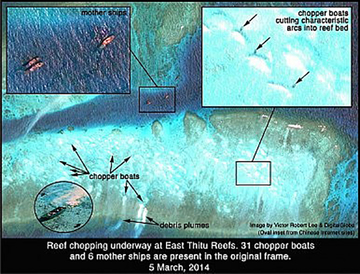

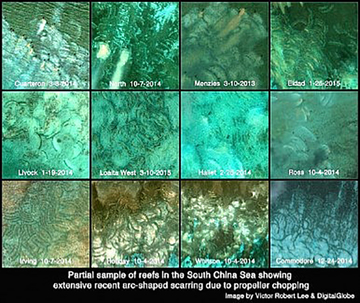


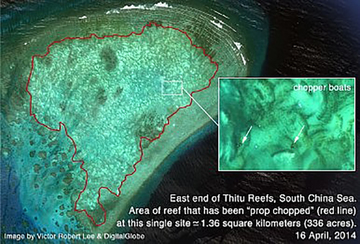

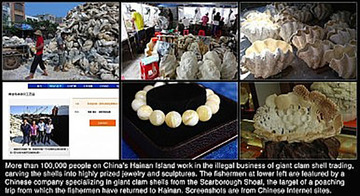
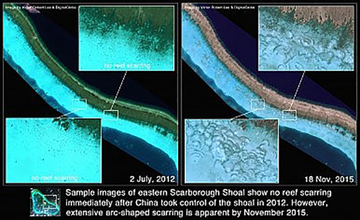

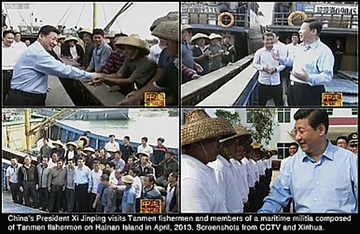
No comments:
Post a Comment
Note: Only a member of this blog may post a comment.